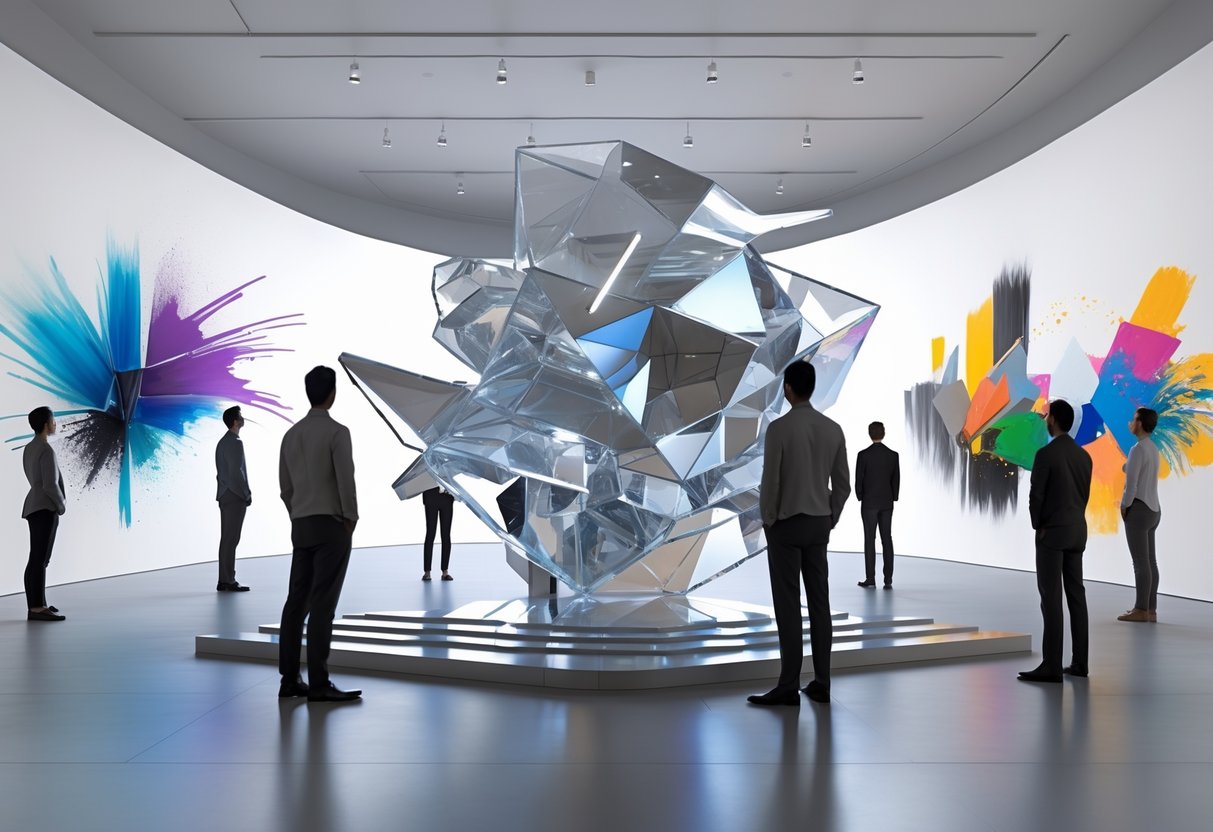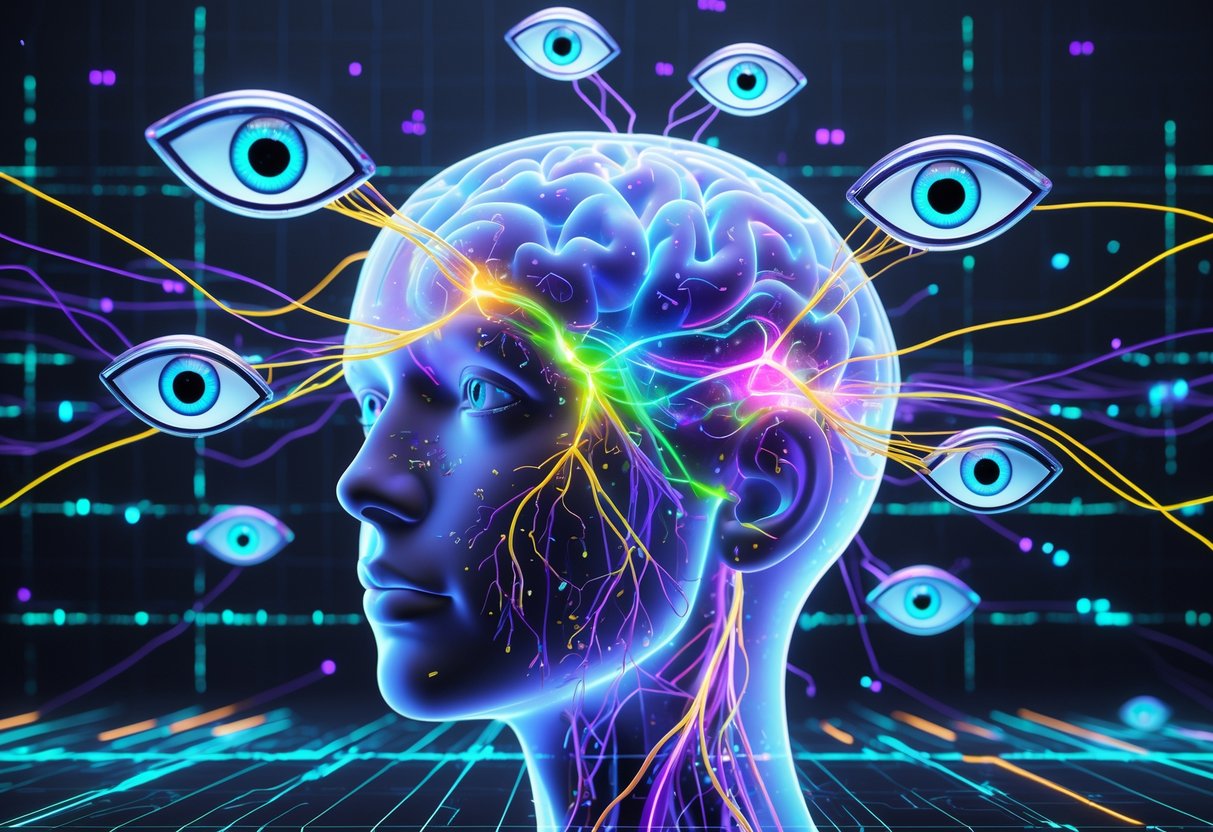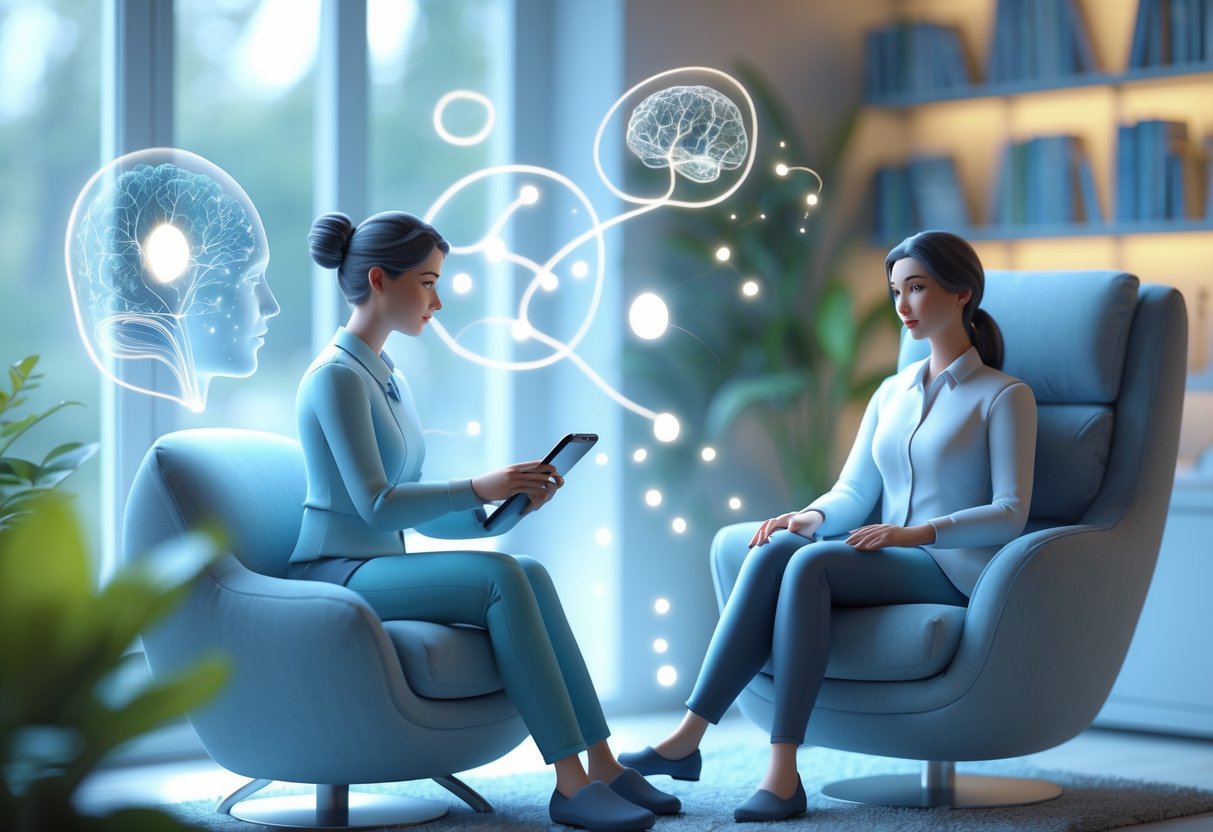Observer Perspectives: Understanding Memory, Art, and Self-Reflection
Updated On: October 23, 2025 by Aaron Connolly
Defining the Observer Perspective
When you take an observer perspective, you see yourself and your experiences from the outside, almost like you’re watching a movie of your own life. It puts some space between you and your feelings, which can help with anxiety, but it might also make you feel a bit disconnected from what’s going on inside.
Core Concepts and Meaning
Observer perspective is basically looking at yourself from outside your body, as though you’re watching a film starring you. Instead of living the moment through your own eyes, you imagine how others might see you.
This shift gives us “psychological distance.” Stepping back helps us view things more objectively.
A few key traits:
- You see yourself like a third party would
- You focus on how you look and act
- You mentally separate yourself from the event
- Your emotions feel less intense because of this distance
The observer perspective often kicks in during stressful moments. Our minds just kind of default to this mode when things get overwhelming.
Researchers have found that this perspective changes how we handle emotions. We get more logical, for better or worse, but sometimes we lose touch with what we actually feel.
Differences From Field Perspective
Field perspective flips things around. Here, you remember events through your own eyes, just as you lived them.
Field perspective means:
- You’re in your own head, seeing what you saw
- Emotions hit you directly and powerfully
- Physical sensations feel real and immediate
- You relive things as they unfolded
Observer perspective brings:
- A third-person, outside view
- Less intense feelings
- A focus on your appearance or behavior
- More analysis, less raw experience
Emotional engagement is the big difference here. Field perspective keeps you plugged in emotionally, while observer perspective pulls you back.
Memory research says we switch between these two depending on the situation. Recent stuff usually gets the field treatment, but older memories tend to go observer mode.
People with social anxiety lean heavily on observer perspective. They’re always worrying about how they come across.
Historical Development
Psychology didn’t always pay attention to how we position ourselves in memories. It wasn’t until the 1980s that the field-observer distinction got any real notice.
Nigro and Neisser ran the first major studies in 1983. They found that people naturally shift perspectives depending on a few things.
They highlighted three main factors:
- Time: Older memories lean observer
- Emotion: Strong feelings trigger observer mode
- Self-focus: Self-evaluation moments push us outside ourselves
Researchers later broadened this view. They noticed observer perspective affects not just memory but also how we plan and perform socially.
Brain scans now show these perspectives light up different areas. Observer perspective taps into self-reflection and social thinking regions.
You’ll see this concept pop up in therapy, too. Therapists use these perspective shifts to help people process tough experiences.
There’s even talk about how digital life—especially social media—might nudge us toward observer perspective, since we’re constantly seeing ourselves from the outside.
Observer Perspectives in Memory Retrieval
When we look back on our past, we can remember things from different vantage points. Sometimes we see through our own eyes; other times, we watch ourselves from the outside. These perspectives actually change how real, accurate, or emotional a memory feels.
Observer-Like Perspective in Autobiographical Memory
An observer-like perspective shows up when you recall memories as if you’re watching yourself from the outside. It’s not the way you originally experienced things.
About 10% of people barely ever use observer perspectives. Most folks can swap between both, depending on what they’re remembering.
When you go observer, a few things shift:
- Visuals aren’t as sharp
- Emotions lose some punch
- You don’t feel like you’re reliving the moment
- You might get fuzzy on where things happened
But there’s an upside. This outside angle lets us update memories with new info and makes our mental picture of the past more flexible.
People tend to stick to their favorite perspective style. If you lean observer, you’ll usually recall most memories that way.
Field Versus Observer Perspectives
Field and observer perspectives are two very different ways our brains rebuild the past.
Field perspective keeps you in the moment, first-person style. You see what you saw, feel what you felt. Memories feel more real and detailed.
Observer perspective puts you outside the action. You see yourself in the scene, but your brain has to piece the whole thing together from scratch.
| Field Perspective | Observer Perspective |
|---|---|
| First-person viewpoint | Third-person viewpoint |
| Higher emotional intensity | Reduced emotional intensity |
| More vivid visual details | Less vivid imagery |
| Better spatial accuracy | Poorer spatial accuracy |
| Preserves original experience | Reconstructed viewpoint |
Recent memories usually stick with field perspective. As time passes, observer perspective creeps in. It’s a slow shift that happens over months or even years.
Memory Malleability and Distortion
Observer perspectives really show how flexible our memories are. When you remember from the outside, you’re not replaying a tape—you’re rebuilding the whole thing.
This rebuilding can mess with accuracy. Observer perspective often makes memories less consistent and more prone to errors than field perspective.
A few things boost this malleability:
- Memory age – Older memories go observer more often
- Rehearsal frequency – The more you recall something, the more the perspective might shift
- Emotional distance – If the memory isn’t loaded with feelings, observer is more likely
- Individual differences – Some people just naturally use observer perspective more
People who almost never use observer perspective tend to have better spatial skills. Their memories also hold onto details and emotions better.
Understanding these shifts helps explain why eyewitness testimony can get shaky over time. Observer perspective is just built into how our memories balance being accurate and being adaptable.
Psychological Effects of Observer Perspectives
Observer perspectives really shake up how we think and feel. They change emotional intensity, memory accuracy, and even the kinds of insights we can get from the past.
Emotional Intensity and Visual Vividness
Observer perspective takes the sting—or the joy—out of memories. When you see yourself from outside, you put up a wall that dulls your feelings.
You don’t relive the moment with the same punch. It’s more like watching a play than being on stage.
Field vs Observer Emotional Impact:
- Field perspective: Emotions hit hard, senses are sharp
- Observer perspective: Feelings are muted, but you see yourself more clearly
This blunting isn’t picky—it works for both happy and sad memories. Even good times feel a little less sparkly from observer perspective. Tough memories lose some pain, but you might also miss out on useful emotional info.
Strangely, you might get a clearer visual of yourself. You notice your body language, your face, how others react. The trade-off? You lose some emotional authenticity.
Impacts on Memory Accuracy
Observer perspective doesn’t always make memories less accurate, but it shifts the focus. You remember what you looked like or how you acted, not so much what you felt.
People using observer perspective often dwell on their own mistakes. It’s like being your own worst critic, since you see yourself from the outside.
This perspective also messes with how you judge your past self. Most of us are tougher on ourselves when we watch from the outside, so we might remember things as worse than they actually were.
Memory Changes Include:
- You focus more on how you appeared
- You remember the layout of the scene better
- Emotional details fade
- Self-criticism ramps up
That said, observer perspective can help you spot patterns or habits you might miss otherwise.
Updating Memories With New Insights
Observer perspective can be a handy tool for working through tough stuff. When you step outside yourself, it’s easier to look at things without getting overwhelmed.
That distance helps you catch new details or connections. Maybe you realize someone supported you when you didn’t notice before. Or you finally see your own strength.
Therapists use observer perspective to help people process trauma. It’s less intense, so clients can look at old pain with a bit more kindness.
Benefits for Memory Processing:
- Less emotional overload when recalling hard times
- Fresh perspective on relationships or conflicts
- Recognition of personal growth and change
- Better understanding of what led to what
Still, it’s all about balance. Observer perspective offers insight, but you don’t want to lose the richness of actually feeling your memories. Both views matter.
Individual Differences in Adopting Observer Perspectives

People really differ in how they remember things. Some almost never see themselves from the outside, while others switch perspectives all the time.
Trait-Like Preferences
Most folks can switch between first-person and observer views. But about 10% almost never go observer.
These habits stick. If you rarely use observer perspective, you’ll keep that up across all sorts of memories.
If you almost never use observer perspective, you probably:
- Always see memories from your own eyes
- Score high on first-person memory tests
- Don’t change much as memories get older
- Find it hard to picture yourself in the scene
This preference works a bit like a personality trait. It shows up in both recent and old memories.
It seems like this style develops early and becomes part of how you process experiences.
Impact on Personal Narratives
People who don’t use observer perspective much remember things differently. Their memories pack more detail and emotion.
They stay connected to their original experience. When they recall something personal, it’s usually more vivid than for typical observer users.
Their memories tend to have:
- More scene-related detail
- Stronger feelings
- Better spatial information
- More consistent accuracy over time
Not shifting to observer might protect memories from getting reshaped. If you stay in first-person, you keep closer to what really happened.
This matters for stuff like eyewitness accounts. Understanding these differences could help in legal settings.
Cognitive and Spatial Abilities
Researchers have found links between observer perspective and cognitive strengths. People who rarely use observer perspective usually have better spatial visualization.
They tend to score higher on tests that measure mental imagery and spatial rotation. Their stronger spatial skills seem to help them stick with first-person perspectives.
These folks often:
- Do well on spatial tasks
- Have vivid mental images
- Process visuospatial info quickly
- Remember where things were more accurately
Spatial ability and memory perspective might share the same roots. If you’re good at picturing spaces, you might find it easier to stay in your own shoes when you remember.
These differences help explain why some people resist the usual shift toward observer perspective as memories age. Their spatial strengths help them hold onto that first-person view.
The Observer Perspective in Social Anxiety
People with social anxiety often picture themselves from the outside during social interactions. Instead of seeing through their own eyes, they imagine how others see them.
This mental shift tends to trap folks in a cycle: negative self-perception ramps up anxiety, which then hurts how they interact with others.
Self-Focused Attention
Whenever social anxiety kicks in, our attention turns inward almost automatically. We start treating ourselves like social objects, not just people in a conversation.
This self-focused attention acts like an inner camera, filming every move. Suddenly, we’re hyper-aware of how we might come across.
We start thinking about our appearance, our behavior, every possible slip-up. Our minds get stuck on things like sweating or trembling, rather than what’s actually happening around us.
Research suggests this inward focus makes it easy to miss positive social feedback. We overlook smiles, nods, or other signs that things are going fine.
Key indicators of self-focused attention:
- Watching your own voice or gestures
- Worrying that anxiety is obvious
- Missing cues from others
- Feeling cut off from the conversation
This kind of focus can wall us off from real connection. It’s like we’re watching ourselves act instead of just being there.
Formation of Self-Image
The observer perspective builds a mental image of ourselves as if we’re watching from across the room. It’s almost like seeing a movie of yourself, not living it.
These mental pictures usually aren’t kind. We might imagine ourselves sweating, fidgeting, or just looking foolish. Our brains use anxiety signals inside us, not what’s actually happening, to draw these images.
Studies have found that people with social anxiety create these observer images way more often than confident folks. We end up confusing our anxious feelings with how we actually look to others.
Common observer perspective images:
- Seeing yourself blush or shake
- Imagining awkward body language
- Visualizing others judging how you look
- Picturing yourself messing up in public
The real issue? We believe these images are accurate. We think others see us just like we see ourselves in these harsh mental snapshots. That belief just keeps the anxiety going.
Observer Perspective in Social Phobia
Social phobia brings a steady fear of being judged in social situations. The observer perspective keeps this fear alive.
When we walk into a situation we dread, our minds flip into observer mode automatically. We create negative images of ourselves and assume everyone else sees us that way too.
These mental pictures feel real, even if they aren’t. People with social phobia tend to use this observer perspective much more than folks without anxiety issues.
This habit causes a bunch of problems:
- Anxiety spikes before and during social stuff
- Negative thoughts about how we’re doing
- Safety behaviors like avoiding eye contact
- Low self-ratings after social events
If we want to break out of this, we have to work at shifting attention outward. Focusing on how people actually respond, not just our imagined flaws, helps break the cycle.
Therapists often suggest exercises to practice seeing social situations through our own eyes, not from some imaginary outside view.
Observer Perspectives and Artistic Expression

Observer perspective shapes both how artists make art and how we experience it. It reaches into everything, from how artists compose a portrait to how we, the viewers, connect with the finished work.
Role in Portrait and Still Life Art
In portraits and still lifes, artists act as observers of the intimate. They watch the quiet corners of homes and studios.
The figures, objects, or even pets in a space become the focus. When we paint a portrait, we’re stepping back, observing our subject from a distance.
That distance lets us see details others might miss. Maybe it’s the way light falls across a cheek, or how someone folds their hands.
Still life painters do the same thing. They arrange objects, then observe how they relate—how a bowl of fruit isn’t just food, but a study in color, texture, and shape.
This observer perspective can create a kind of intimacy. Viewers feel like they’re peeking into private moments. That connection starts with the artist’s careful observation.
Artists as Observers and Creators
Artists wear two hats: observer and creator. They watch the world, then make something from what they’ve seen.
Sketching outside, we might start by just watching. We notice how shadows stretch across a building, or how people move down a street.
These observations feed right into our creative choices.
An artist’s unique viewpoint shapes what they make. It also affects how others feel when they see the work.
Sometimes, artists look at their own work with an outside eye. They step back to see their paintings as if for the first time. That helps them spot what needs to change.
Viewer Engagement Through Perspective
The observer perspective doesn’t just matter for artists—it changes how viewers connect with art, too.
Looking at a painting, we take on our own observer role. We bring our backgrounds and experiences to what we see.
Different viewers notice different things in the same artwork. One person might be drawn to color, another to brushwork. This variety makes talking about art so interesting.
Artists can guide how we see their work by choosing certain perspectives. A low angle, for example, can make a subject look powerful; a high angle might make them seem small or vulnerable.
The back-and-forth between what the artist intends and how we see it creates meaning. Artists share their view, and we add our own, finishing the experience together.
Observer Perspectives in Narrative and Storytelling

Writers use the observer perspective to tell stories from a neutral spot, just watching events instead of diving into characters’ minds. This approach puts some distance between readers and characters, so we have to pick up on feelings through actions and dialogue.
Third-Person Viewpoint
Third-person observer narration puts us outside the story, watching characters from afar. The narrator acts like a camera, showing us what happens but not what anyone is thinking.
This “fly on the wall” style makes readers work a bit harder. We have to figure out emotions from body language, speech, and what people do.
Key features include:
- Uses “he,” “she,” and “they” pronouns
- Little to no access to characters’ thoughts
- Focuses on what’s visible
- Keeps a neutral, detached tone
Writers often use this for dramatic scenes. It builds suspense because we never know what characters will do next.
The distance keeps things mysterious. We might see two people argue, but can only guess what they’re really thinking.
Actor Versus Observer Narration
Actor and observer narration change how we understand stories. Actor narration comes from someone inside the story, while observer narration comes from someone outside, just watching.
Actor narration:
- Gives a personal take on events
- Shows emotional investment
- Brings in personal bias
- Involves the narrator directly in scenes
Observer narration:
- Sticks to the facts
- Stays emotionally detached
- Remains neutral about characters
- Doesn’t take part in the action
This difference matters because it affects how much we trust the narrator. Actor narrators might hide things or get it wrong because they’re involved.
Observer narrators feel more reliable, but they might miss emotional details an insider would catch.
Acentred Memory in Stories
Acentred memory happens when stories show events without a main character’s viewpoint guiding them. Instead of one person’s memory shaping things, events just seem to happen.
This style makes stories feel more like documentaries. We get multiple viewpoints without any single one taking over.
Writers do this by:
- Switching between different characters’ observations
- Presenting events in order, with no emotional filter
- Skipping internal monologue or personal reflection
- Keeping a steady narrative distance
The result feels more like a historical record than a personal story. Events just unfold, not colored by anyone’s memory.
This approach works well for big, complex stories with lots of characters. No one viewpoint dominates.
Philosophical Implications of Observer Perspectives

Observer perspectives shake up how we think about personal identity, memory, and even consciousness. These questions get tricky when we realize how much our viewpoint shapes who we think we are and how we experience reality.
Point of View in Personal Identity
Our sense of self leans a lot on which observer perspective we use. When we look at ourselves, are we really the same person we were yesterday?
The first-person perspective gives us a sense of continuity. We feel like the same person, with the same memories and thoughts, moving through time.
Third-person perspectives make things messier. Other people might see us as completely different depending on the situation or time.
Philosophers call this the persistence of identity problem. If our bodies and minds change, what keeps us “us”? The answer seems to change depending on which perspective we take.
Think about multiple personality disorder. From inside, each personality feels like the “real” one. From outside, they’re all part of the same person.
So, observer perspectives aren’t just abstract ideas. They touch real-life questions about who we are and how we relate to others.
Problems of Acentred Memory
Most memory relies on a central observer—someone who experienced and remembers the event. But what if there’s no clear “me” in the memory?
Acentred memory means memories exist without a clear observer. Dreams often work like this. We remember the dream, but can’t always say where “we” were in it.
Some meditation practices aim for this state. People sometimes report experiencing things without any sense of being the observer. The memory is there, but there’s no “rememberer.”
This leads to some philosophical puzzles. If memories don’t need a central self, what does that mean for identity? Are we just a bundle of experiences?
Neuroscience seems to back this up. Scans show no single spot in the brain for the “self.” Instead, lots of areas work together to create the feeling of a unified observer.
Therapy and healing can use this idea. People might process trauma differently if they don’t identify so strongly with being the observer of painful events.
Self-Reflection and Consciousness
Self-reflection turns us into our own observers. That’s where the “hard problem of consciousness” comes in.
When we think about our own thoughts, who’s actually doing the thinking? We become both subject and object, which is kind of mind-bending.
Levels of self-awareness show up here:
- Basic awareness (knowing we exist)
- Reflective awareness (thinking about our own thoughts)
- Meta-awareness (knowing we’re aware)
Each step needs a different observer perspective. We flip between being the doer and the watcher.
Buddhism and other traditions dig deep into this. They sometimes say the observer and the observed are both illusions. What’s left is just raw awareness.
Modern uses include mindfulness and cognitive therapy. Both help us watch our own minds without getting stuck.
People who can shift between different observer perspectives often seem more emotionally resilient. Maybe that’s a key to mental health.
The Neuroscience of Observer Perspectives

When we remember events from a third-person viewpoint, our brains light up differently than when we recall things through our own eyes. This shift sparks specific brain networks and changes how regions talk to each other.
Brain Mechanisms Involved
When you recall a memory from an observer perspective, your brain lights up in some interesting ways. The anterior hippocampus teams up more with the posterior medial network whenever you picture memories from outside yourself.
This happens because seeing things from the outside isn’t just a replay—it’s a reconstruction. Your brain has to rebuild the scene almost from scratch.
Key brain regions involved:
- Anterior hippocampus
- Posterior medial network
- Ventromedial prefrontal cortex
- Medial temporal lobe structures
The hippocampus really takes the lead here. It pulls together different networks to make that observer experience possible.
Researchers have found that observer perspectives actually engage the autobiographical memory network less than first-person memories do. So, our brains seem to treat these “outside” memories as a different category.
Shifting Visual Perspectives
Switching between first-person and observer views isn’t automatic. Your brain has to put in some work.
When you flip to an observer perspective, you’re generating new imagery on the fly. It’s like directing a mental movie where you’re both the actor and the audience.
This taps into brain regions for:
- Creating mental images
- Spatial processing
- Visual reconstruction
The shift usually kicks in right when you start recalling the memory. Your brain quickly decides which angle to use.
Connectivity between regions changes a lot during this shift. Suddenly, brain areas that don’t usually work together start linking up.
Some people seem to slip into observer mode more easily than others. That probably comes down to how their brain networks are wired.
Cognitive Flexibility and Perspective Taking
Going into observer mode takes real cognitive flexibility. It’s not easy to step outside yourself, and it shows off just how adaptable our brains can be.
Different mental skills have to work together for this to happen. You hold onto the memory details, but at the same time, you’re building a whole new viewpoint.
Cognitive processes required:
- Spatial reasoning
- Visual imagery generation
- Memory reconstruction
- Emotional regulation
People who don’t use the observer perspective much show different brain activity. They might remember the scene better, but they’re less flexible emotionally.
Therapists often use observer perspectives to help people distance themselves from tough memories. Seeing things from the outside can take the sting out of them.
This ability to shift views keeps developing as we grow up. Mature brain networks make it possible to juggle all the mental steps.
Neuroscience keeps showing us just how flexible our memory systems can be.
Applications in Therapy and Mental Health

Therapists are using the observer perspective more and more, especially for anxiety disorders and trauma recovery. This technique helps clients get some emotional distance from difficult thoughts and opens up space for healthier responses.
Observer Perspective in Cognitive Behavioural Therapy
CBT therapists often encourage clients to switch from observer to field perspective during social situations. That can help break cycles of anxiety and negative thinking.
When you’re socially anxious, you probably see yourself from the outside. You imagine what others see, sometimes picturing yourself as awkward or embarrassed.
Key CBT techniques include:
- Helping clients spot when they’re using observer perspective
- Practicing field perspective in role-plays
- Challenging harsh self-images that come from seeing yourself from the outside
Studies show that socially anxious people do better in social tasks when they use a field perspective. They end up with fewer negative thoughts and less anxiety.
The observer perspective tends to keep social anxiety going, since it makes you focus inward instead of noticing positive feedback from others.
Managing Distressing Memories
Therapists teach clients how to look at traumatic memories from a distance, so they don’t get overwhelmed. This helps create some breathing room from painful events.
The observer self lets you watch your thoughts and feelings without being swallowed up by them. You can face tough emotions but still keep your balance.
Therapeutic benefits include:
- Less emotional overwhelm when recalling trauma
- More power to challenge negative thought patterns
- Better awareness of automatic reactions
Clients practice stepping back and observing their responses with curiosity, not judgment. This approach helps break the cycle of rumination and self-criticism.
It’s especially useful for anxiety, depression, and PTSD.
Therapeutic Benefits and Limitations
Observer perspective has some real upsides in therapy. It builds self-awareness and emotional regulation skills that last beyond the session.
People often find they get less stuck on negative thoughts, grow more flexible, and make choices based on their values instead of fear.
Still, it’s not a fit for everyone. Some folks find it weird or even disconnecting at first.
Potential limitations:
- Can feel awkward or artificial at the start
- Needs practice to click
- Not great for people in crisis
Therapists need to judge when and how to use these techniques. Timing and client readiness matter a lot.
Observer perspective usually works best alongside other therapy tools, not as a solo solution.
Practical Techniques for Adopting Observer Perspectives

Learning to see yourself from the outside takes practice, but you can get better at it with a few simple strategies. These range from structured exercises to daily habits that help you step back and see things more objectively.
Guided Imagery Strategies
Start with basic visualisation exercises. Find a quiet place, close your eyes, and picture a recent memory. This time, don’t see it through your own eyes—watch yourself like a character in a movie.
Begin with neutral memories. Maybe you’re having breakfast or walking to the shop. See yourself from above or across the room. Notice your body language and expressions, but try not to judge.
Try the “fly on the wall” approach. Imagine you’re invisible, just watching your interactions. What stands out about how you move or talk?
Move on to emotional memories once you’re comfortable. Watch yourself in a mild argument or a happy moment. This builds your ability to gain perspective on trickier situations.
Guided meditation apps can help too. Lots of them have exercises for building “observer perspective”—the skill of watching your thoughts without getting tangled up in them.
Mindfulness and Self-Observation
Try the “witness self” habit every day. Stop now and then to ask, “What am I thinking? How do I feel? What’s my body doing?” This gives you a bit of distance from your reactions.
Set phone reminders to check in with yourself. When the alert goes off, pause and observe your current state as if you’re looking at someone else.
Use the “helicopter view” exercise. When things get stressful, picture yourself rising above the scene. What would you notice from up there? How might things look to an outsider?
Breathing exercises help too. Take five deep breaths and imagine stepping back from whatever’s happening. This physical pause can trigger the mental shift to observer mode.
Try describing your emotions in the third person. Instead of “I’m furious,” say “I notice anger” or “There’s frustration.” It’s a small change, but it helps create space.
Everyday Use for Personal Development
Use observer perspective in conflict. When someone gets on your nerves, imagine telling a neutral friend about the scene. What would you honestly say about everyone’s behavior?
Try it for big decisions. Before you choose, ask yourself, “What would I tell a friend in this situation?” That trick can cut through emotional bias.
Practice during conversations. Every so often, step back and notice the flow. Are you really listening, or just waiting to talk? How’s the other person reacting?
Keep a journal from the third-person view. Write about your day as if you’re an outside observer: “Today, [your name] handled the deadline by…” This helps you see yourself more clearly.
Test out role reversal. If you’re disagreeing with someone, try arguing their side for five minutes. It’s a challenge, but it builds your ability to see things from more than one angle.
Future Directions and Research on Observer Perspectives

Researchers are finding new ways to study how we remember events from different perspectives. They’re also testing how this knowledge could help people with memory problems or mental health challenges.
Emerging Studies
Scientists use brain scans to track what happens when we shift memory viewpoints. They mix fMRI scans with personal stories and self-ratings to see which networks get involved.
Some researchers focus on people who rarely use observer perspective. These folks often recall richer details about scenes. Scientists are curious why some naturally use one perspective more.
Studies are looking at how observer perspective connects to emotion. Researchers wonder if culture shapes how we view memories. For instance, people from Asian American backgrounds might actually benefit from observer perspective when thinking about negative future events.
Brain imaging is revealing what it looks like when we switch perspectives. This is helping us map out the neural basis for these shifts.
Potential Applications
Observer perspective research could lead to better treatments for depression and anxiety. Therapists might teach people to view tough memories from the outside to ease the pain.
Memory training programs could use this to help people with recall issues. Teaching someone to shift perspective might boost their memory for important events.
Education could get a lift from these techniques too. Students might learn better by imagining themselves from different points of view.
Clinical applications include:
- Trauma therapy
- Depression treatments
- Anxiety management
- Memory rehab programs
Virtual reality might even combine with observer perspective research. That could create safe ways for people to process hard experiences.
Open Questions
We still don’t know how observer perspective connects to other mental activities like mindfulness or daydreaming. Scientists want to explore those links.
Extreme cases are a mystery too. Some people almost never use their own eyes in memories, while others can’t use either viewpoint at all.
Key questions include:
- How do observer perspectives develop in kids?
- Can we teach people to switch perspectives more easily?
- Does observer perspective change how accurately we remember things?
- How do cultural backgrounds shape memory perspectives?
We need more research on whether seeing ourselves from outside makes memories less accurate or just different.
Some scientists even wonder if observer memories are “real” memories at all. That debate could change how we think about human memory.
Frequently Asked Questions

Observers play all sorts of roles in research and therapy. Understanding what they do helps clear up how observation works, and why it matters for bias and methodology.
What are the main functions of an observer in qualitative research?
Observers gather detailed information about actions, interactions, and settings that participants might not notice or mention. They write down what’s happening as it unfolds.
Their main job is to systematically record what they see, not to explain why it happens. That means noting actions, timing, and context.
In ethnographic research, observers often spend long stretches in the field. They piece together social dynamics and cultural practices.
Observers also act as neutral witnesses. That’s especially useful in therapy or group studies where different viewpoints matter.
Can the presence of an observer influence the behaviour of those being studied?
Yes, people often change how they act when they know someone’s watching. They might behave more formally or try to look good.
Usually, this effect fades as people get used to the observer. Researchers call this process “observer reactivity.”
Some studies use hidden observation or one-way mirrors to cut down on this. Still, ethical rules now require informed consent most of the time.
Researchers need to acknowledge this limitation. Good analysis always takes possible observer effects into account.
How can observer bias be minimised in experimental studies?
Training several observers and comparing their notes helps spot inconsistencies. This is called inter-rater reliability, and it keeps observations steady across people.
Structured observation forms can reduce personal interpretation. Clear definitions and standard methods help limit bias.
Blind observation keeps observers from knowing the study’s aims or group assignments. That way, their expectations don’t color what they notice.
Regular calibration sessions help everyone stay on the same page. These meetings fix the drift in interpretation that naturally happens over time.
What methods are used to record observations in a research setting?
Most researchers stick with written field notes. They usually jot things down fast, using shorthand or structured forms.
Some people use video or audio to capture everything for later review. Still, setting up that kind of equipment can feel disruptive, and you’ll need extra consent from participants.
Digital tablets and smartphones have changed the game. Loads of researchers now use apps made for observational coding, so they can enter data right as things happen.
Time-sampling is another trick. Researchers record behaviors at set intervals, which works especially well for frequent actions that are tough to follow non-stop.
In which ways does the observer’s role differ between participant and non-participant observation?
Participant observers actually join in the activities while collecting data. They get to see things from the inside, even though they have to stay focused on their research.
Non-participant observers, on the other hand, keep their distance. They watch from the sidelines and don’t get involved with the group.
Getting involved as a participant observer can reveal more about group dynamics and what motivates people. But honestly, it’s tough to stay objective when you’re playing two roles at once.
Non-participant observers stick to clearer boundaries, which makes things simpler. The downside? They can miss out on subtle interactions and might not fully grasp the context without firsthand experience.
Choosing between the two really depends on your research questions and what’s actually possible in the setting. Sometimes, mixing both methods gives you the fullest data collection picture.
What strategies are effective for maintaining objectivity while conducting observational research?
Start by acknowledging your own biases. It’s surprising how much just being aware of them can help you stay objective.
Take time for regular self-reflection. That way, you’re less likely to let assumptions sneak into your notes.
Bring in more than one observer for the same events. When you compare notes, it’s easier to catch those little slips where bias might have crept in.
Different perspectives can highlight what you might’ve missed. Honestly, sometimes you don’t even realize you’re seeing things through your own lens.
Stick to structured observation protocols. When you have clear definitions for behaviors, you don’t have to guess or fill in the blanks.
That structure leaves a lot less room for personal interpretation. It’s just less stressful, too.
Ask for regular supervision or peer review during data collection. A new set of eyes can spot bias you didn’t notice.
Always separate observation from interpretation. First, write down exactly what happened—don’t jump ahead to what it means.
Save the analysis for later, after you’ve got the facts straight.

